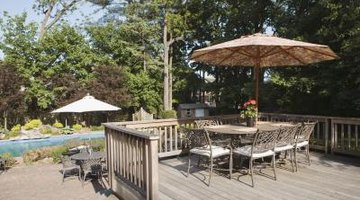How to Use Hemlock as a Decking Material
A deck provides an outdoor place to gather and relax. Among the many considerations when designing your deck is what type of lumber to use for the project. Hemlock is an attractive, light-colored wood that is comparable in price to pine or cedar. Although hemlock is classified as a softwood and cuts smoothly, the wood of a hemlock can be as strong as hardwoods if handled properly before you use it as decking material.

Step 1
Select the correct species of hemlock lumber. Western hemlock makes a better building material than Eastern hemlock due to its smoother grain and greater longevity. Western hemlock, unlike Eastern hemlock, doesn't contain resin, and this makes it easier for the wood to take paint or stain.
Step 2
Buy only treated hemlock. Left exposed to the elements, untreated hemlock will degrade rapidly and your deck will fall apart within a few seasons. Once treated, the dense hemlock wood will resist rot and insects. Over time, the wood hardens, which increases its strength and longevity.
Step 3
Purchase only dried hemlock or have the lumber dried by a professional. Hemlock has a large shrinkage when it dries. If you build your deck with wet wood (also known as green wood), you will be left with large gaps in the deck once the wood dries. Drying the wood also increases its strength and reduces the weight of wood, making it easier to carry.
Step 4
Cut your hemlock with a power saw or handsaw. The power saw will make a smoother cut than the handsaw. Because hemlock is soft, cutting the wood has little dulling effect on your blades. If you use Eastern hemlock, clean the blade between cuts to clear away the resin residue.
Step 5
Use screws with your hemlock rather than nails. The wood doesn't retain nails well. Screws make a better choice for any building project because the threads help hold everything together better than nails do. Hemlock accepts and grips screws well. Drill a guide hole slightly smaller than the diameter of your screw before inserting the screw. This helps keep the wood from splitting as you place the screws.
Step 6
Sand your deck floor once it's completed. Sanding makes the surface of the deck smoother and improves the appearance of the wood. After sanding, sweep the deck clean. At this point, you can stain or paint the deck if you want.
References
Resources
Tips
- Your deck will require posts, support joists and floor decking. In addition, you'll need to buy decking screws, hardware and cement. Because each deck design is different, this article is only a guide for how to use hemlock as a decking material, not how to construct a deck.
- Always check with your area's building codes before starting work on your new deck.
Warnings
- Wear safety glasses when cutting wood to avoid getting anything in your eye.
Writer Bio
Based in Portland, Ore., Tammie Painter has been writing garden, fitness, science and travel articles since 2008. Her articles have appeared in magazines such as "Herb Companion" and "Northwest Travel" and she is the author of six books. Painter earned her Bachelor of Science in biology from Portland State University.
Photo Credits
- Thinkstock Images/Comstock/Getty Images
More Articles



